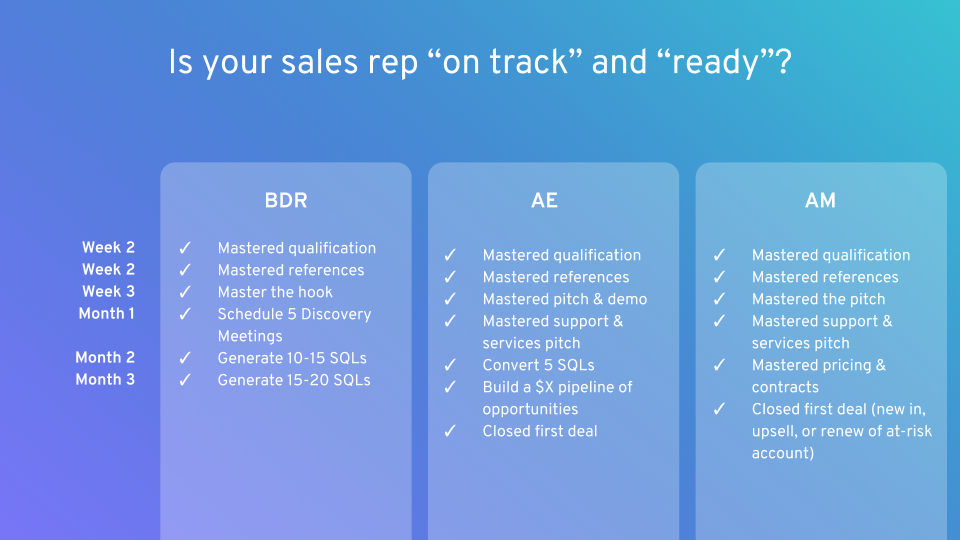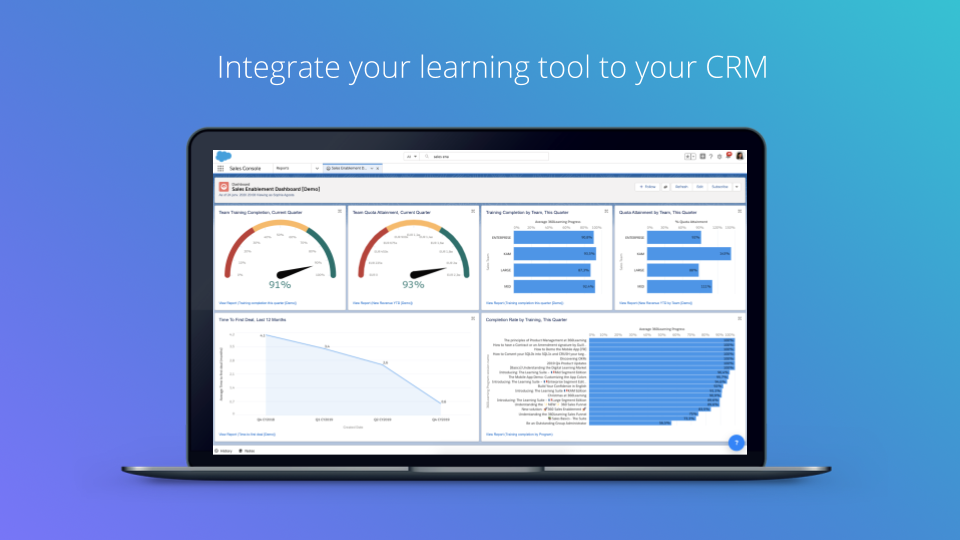4 Straightforward Steps to Measure Your Sales Training Impact

Author: Joei Chan
Sales training is critical to boosting deals and shortening ramp-up time for new reps. However, as every sales trainer knows, training can be an expensive and time-consuming process. Some sales reps are even reluctant to commit to training, as they don’t see an immediate impact as a result.
That’s why it’s so important to measure and demonstrate the positive impact of your sales training. Showing exactly how training contributes to your bottom line encourages your reps to dedicate the necessary time and effort to their learning, and also secures buy-in from executives and managers.
In this post, we’re here to show you how to measure the impact of your sales training in four straightforward steps. Even if you’re managing your sales rep training in a remote context, you can use these steps to set clear metrics, prove your impact, and get sales reps and executives on board.
Let’s start with why it’s important to measure your sales training impact.
Why you need to measure your sales training impact
In every business, resources are limited. So, whether you’re making a case for investment in tools, technology, or training, you need to show your training ROI and how this will contribute to company performance.
Perfecting sales skills takes time, patience, and a lot of practice. In fact, it can take weeks or even months for your best reps to truly master their scripts and close their first deal. Even so, plenty of managers and executives want to see evidence of training benefits straight away.
Measuring the impact of your sales training – and telling a clear, compelling story about this impact – is critical to getting everyone on board. By tracking the right set of metrics, you can show exactly how your sales training saves money and boosts revenue.
Now let’s take a look at step one: identifying the metric you want to impact.
Step #1: Identify the sales metric you want to impact
All great measurement begins with answering one question: which metric(s) are you hoping to impact?
At 360Learning, we start by focusing on two main sales enablement KPIs:
- Quota attainment: How many reps are hitting their quarterly goals?
- Time to first deal: How fast are we ramping up new sales reps?
These are the two spots where we’re really trying to move the needle. Tracking exactly how many of our reps are meeting or exceeding their goals helps us pinpoint the impact of our training activities, and show where we have room for improvement.
The same goes for ramp-up. We want our reps to hit the ground running, and our sales training is a big part of helping them find their rhythm. We need to know how well it’s working.
We also use the following time-bound KPIs to measure whether a sales rep is on track, split out into our three different sales roles: business development representatives, account executives, and account managers:

Examples of ramp-up metrics we track for new sales reps based on their roles
As you can see, the metric of success for each sales role varies based on their scope. You might have your own set of metrics adapted for your sales teams. Map this out and identify the right KPIs you’re looking at for each sales rep before you start training.
Now you’ve decided which metrics you want to impact with your sales training, you have to think about how to measure them.
Step #2: Decide how you’ll measure your sales training performance
Measuring the impact of sales training is about drawing a clear and direct line between your training activities and the impact you want to see as a result.
Say you’re planning a session analyzing your key competitors and their products. You need to frame your measurement in terms of the benefits stemming from this training – a greater depth of knowledge about your product’s strengths and weaknesses when compared to the other solutions on the market.
You could measure the impact of this training by tracking the percentage shift in the number of deals you secure against your competitors before and after training. This metric tells a clear and distinct story on whether your training is achieving its goal or not.
You could also set milestones for each quarter, such as a 5% increase in deals secured. Before you set these milestones, however, you need to make sure they’re realistic in light of the data you’ve collected so far.
Another added bonus? If your measurement tells you one particular type of training is having a positive impact, you can double down because you know it works. This helps you to set your future training strategy and priorities, too.
Next up, you need to decide which tools to use in measuring your sales training impact.
Step #3: Know which sales training tools to use
Getting started with measuring the impact of your sales training can be tough. On top of setting the right metrics and targets, you need to decide how to gather data, and how to use this data to tell a clear story. The right set of tools can make this a lot easier.
With a sales training platform like 360Learning, you can track your sales reps as they engage with training, and can see how people are progressing with their learning programmes. You can also collect qualitative feedback on individual modules, and leverage subject-matter experts to co-create and improve training content.
You can also integrate your training platform directly with your CRM tool. For example, 360Learning’s easy integration with Salesforce helps you to track metrics like quota achievement, training completion rates, and time to first deal.

Linking your training platform to your CRM helps you track your sales training impact
On top of that, we also offer a handy training ROI calculator to help you work out exactly how much your training initiatives are contributing to your company’s bottom line. Determining this ROI helps you to know how to prioritize your training.
Finally, our fourth step – turning the data into an effective story.
Step #4: Communicate the training results
Tracking the right metrics is one thing. Now, you need to tell a clear and compelling story about what the data has to say.
What trends do the numbers show? Which ones are working extraordinarily well, and which ones should be killed?
Keep your conclusions and observations as simple as possible, and tell a clear story of how investments in training are contributing to the bottom line. You can frame this as a series of slides, a set of graphs or charts, or a simple email summarizing your key points.
Once again, integrating your learning platform with your CRM makes this a lot easier. For example, 360Learning’s integration with Salesforce makes it straightforward to generate clear and comprehensive reports on training performance.

Example of 360Learning’s Salesforce integration
Remember, some trends are only observable over a longer timescale, so don’t make decisions too quickly. You may not see an immediate impact on closing rates as a result of introducing a new module, but tracking this over the quarters will help to tell a clear story.
And while we’re on the subject of impact…
Always focus on the bottom line
By framing our sales training performance in terms of the impacts on the bottom line, we make it easy for decision-makers to understand why this training is important, and why it deserves their time, attention, and effort.
So, if you’re looking for ways to measure and demonstrate the impact of your sales training, focus on the contribution to reducing ramp-up time, increasing deals closed, and contributing to rep quota attainment.
By showing how training contributes to company profitability, you make a stronger case for your reps to prioritize their learning, and help to secure support at the executive level.
All you need to do is identify the metrics you want to impact, decide how you’re going to measure your performance, know which tools to use, and finally, communicate the results in clear, simple terms.
Joei Chan is the Director of Content at 360Learning. She’s passionate about telling the #CollaborativeLearning story to whoever’s listening. You can follow her onboarding journey with 360Learning’s original docu-series by Googling #OnboardingJoei.
Experience and a lot of testing have shown us that it is possible to create email templates that people actually resonate with.
You don’t have to figure it out alone, whether you’re starting off as a sales representative, looking to improve your game or providing your team with expert advice, we have your back!